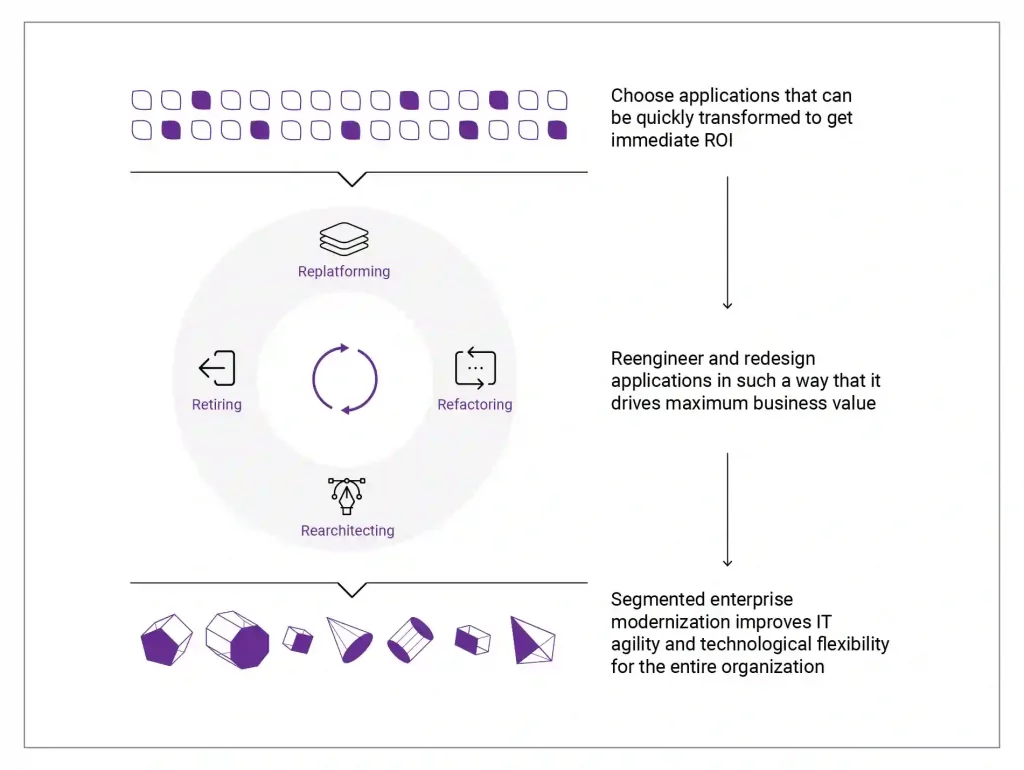Application Modernization
Businesses need to upgrade their systems and operations regularly to provide customers with an optimal experience. Moreover, technological advancement has compelled businesses and organizations to quickly adjust to the fluctuating trends and minimize time spent marketing and selling products.
Application modernization, combined with cloud-based platforms, serves as an economical way for businesses to stay ahead of the trends. In addition, this modernization empowers firms to add efficiency to their processes and move towards a more resourceful digital future.
However, modernization can prove costly for businesses that haven’t invested in a methodological approach. If you plan to move forward with this initiative, you can implement strategically-targeted transformation projects that encourage broader modernization.
What Is Application Modernization?
Application modernization is an approach to upgrading previous software programs to meet the new demands and introduce novel computing approaches. This could include integrating new features, updated languages, frameworks, and infrastructure platforms.
Also known as legacy modernization, the approach allows firms to update their existing systems to improve efficiency and streamline operations. By taking this initiative, organizations can avoid investing in new solutions by leveraging technology to increase the lifespan of their existing applications.
The Processes Involved In Application Modernization
Application modernization is an approach that allows you to re-engineer a current application to attain a cloud-native architecture that best meets the organization’s existing needs.
In most cases of application modernization, businesses fail to maintain feature parity with the older versions of the application, which prevents them from attaining optimal results. Additionally, when the process of legacy migration is not proficiently planned, businesses can miss out on the chance to eliminate features of the application that have not been frequently used in the past. This can hike up expenses and keep the application from running optimally.
Therefore, the reengineering and redesign phases of application modernization must analyze and identify the components that are no longer required. This initiative allows organizations to create a proper plan for integrating new features while reimagining applications.
If your organization is undergoing the application modernization process, you need to create a detailed action plan. To start, identify what your users need and compare those requirements with the business goals and metrics. Essentially, you can then implement the modernization process to ensure complete optimization in your business practices.
That said, legacy modernization emphasizes a single application or specifically clarified applications. The process can be implemented in one of four ways:
Replatforming
Legacy modernization also includes re-platforming to the cloud. With this approach, minimal changes are implemented to ensure that the program can run in the cloud. For instance, re-platforming can be the ideal choice for businesses that can optimize their operation by using a cloud-based deployment model. However, re-platforming would become essential if the firm’s existing software lacks the required architecture that enables cloud compatibility.
Refactoring
Refactoring occurs when the business requires product evolution, but its current application needs restructuring to cater to that request. For instance, your business can go for refactoring if you wish to add an API layer to a legacy application to reveal its core assets.
Rearchitecting
If you have a high-value legacy application that experiences fluctuations, re-architecting it would be the right thing to do. This process ensures that the application undergoes a cloud-native rewrite, which further paves the way for product evolution and new feature development.
Additionally, you can also take on this approach to disengage the core business capabilities to optimize application stability. Or you could use it to move to cohesive, protractile application architecture.
Retiring
Software applications, or their feature sets, are retired with the objective to cut down application complexity, identify technical perforations, and eliminate any component that does not offer value to the business or its application.

Why is Application Modernization Ideal for Low-Budget Businesses?
Implementing application modernization is ideal for businesses looking for a cost-effective solution. The process can be segmented to provide partial modernization that creates a foundation for a broader, enterprise-wide modernization that you can execute in the long run.
All in all, modernization on a small scale sets a stepping stone for full-scale legacy modernization. By starting small, you can make the necessary improvements in the workflow in a unified application and continue to bring value to your business.
When you are initiating your modernization strategy, you can:
- Try out different approaches and features without investing a large number of resources
- Assess the results of modernization by examining the positive outcome following its implementation. This can encourage your business to plan for long-term modernization
- Add efficiency to operations that require the most updates. It can help improve responsiveness, agility, and speed in your organization’s applications
Benefits of Application Modernization
Legacy modernization provides businesses with several advantages. Let’s look at how your organization can benefit from this approach:
More Effective IT Agility
Research shows that 76% of organizations with successful modernization saw improvements in IT agility. Undergoing this process also empowered businesses to reduce their time-to-market by 10.3%.
That said, implementing modernization further assists businesses in increasing developer efficiency. This is because the applications are liberated from legacy monoliths, and the application is shifted or re-architectured to a new cloud platform. This process streamlines the process for further development.
Essentially, when applications are detached from legacy interdependencies and are moved to a flexible cloud platform, your developers can use advanced tools and practices to improve the associated workflows. As a result, developer efficiency is guaranteed.
Implementing this process also allows your team to experiment better and create new integration much faster. You can also remove or upload applications without any hindrances and minimize the application’s time-to-market.
Improved Flexibility
Since the process decreases the time to market, you can add agility to your business model. Moreover, the application modernization process has a segmented nature, which makes it easier for your developers to make the necessary changes.
As a result, you can easily cater to the changes in the market by swiftly adjusting your services instantly. For instance, if a customer demand or market force fluctuates, your business can stay ahead with legacy modernization.
Additionally, you can also make use of a development process for these applications, which can assist in identifying various ideas, including the likes of continuous delivery and platform thinking. Finally, you can defend the need for an all-enterprise modernization using these outcomes.
Inviting Talented Resources
Undergoing the process of application modernization can equip your team with experienced and talented resources. This is because in-demand engineers and developers gravitate towards organizations that streamline their operations and use their expertise to refine work processes using cloud tools and cloud-native methods. Additionally, the process builds your organization’s reputation and helps you train recruits more effectively.
How to Effectively Carry Out Application Modernization
App modernization needs to be thoroughly planned to provide benefits to your organization. Let’s explore a few ways you can plan this process:
Identify Apps With High ROI
It is essential for businesses with a limited budget to create a quick returns strategy. This is why you need to identify the applications that yield a high ROI after they are modernized. With this approach, you can explore the following:
- Your business’s foundational capability?
- The technical criteria. This may include legacy applications, the complexity of code, code hygiene, cost optimization opportunities, and coupling
You can then amalgamate the preceding information to create a foundation for your modernization approach.
Identify Your Business Needs
Essentially, application modernization must serve a purpose. This is why it is imperative to identify and write down your business’s short and long-term needs. This step will help you create objectives for modernization, which will influence the refactoring, re-architecturing, and re-platforming stages.
Pave the way for Future Modernization
Application modernization should be an ever-changing process. Therefore, you need to create a plan that allows your business applications the flexibility to evolve with the market’s fluctuating needs over time. Consequently, you must consider the evolutionary architecture methods, platform thinking and plan deep continuous delivery to ensure your business remains ahead in digital advancement.
The Bottom Line
The current digital atmosphere has made it imperative for businesses to integrate the latest technology to improve operations and delivery. Your organization can reap several advantages from undergoing application modernization. However, it is essential to make sure that you start the process by prioritizing high returns at the initial stage.
This will give you more reasons to implement future modernization. In addition, creating a strategic approach to modernization will certify that your engineering team includes talented resources, which can quickly perfect the applications over time. Finally, undergoing calculated modernization will enable you to maximize value from cloud migration, benefit from a high ROI, and collaborate with a cloud-native firm.










